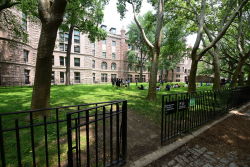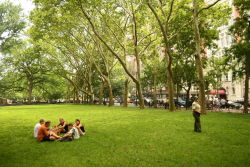Theodore Roosevelt Park
Theodore Roosevelt Park
This Upper West Side park, home to the American Museum of Natural History, honors New York City Police Commissioner, Governor of New York State, Vice-President, and (following William McKinley’s assassination) the youngest man to serve as President of the United States: Theodore Roosevelt (1858-1919).
Americans most often remember Roosevelt as the assertive politician who advised the nation to “speak softly and carry a big stick,” but the New York City native was also a scholar of natural history and a devoted conservationist. As president, he was instrumental in the creation of the National Zoo, the establishment of 51 national bird sanctuaries, and the preservation of 18 natural wonders including the Grand Canyon. The magna cum laude Harvard graduate (Class of 1880) and Nobel laureate (Peace Prize, 1906) wrote three dozen books, ranging in subject from Charles Dickens to African big game hunting. The Museum contains specimens that Roosevelt himself shot and collected during his family’s visit to Egypt in 1872.
In 1807, the City of New York mapped this land as a public park but did not officially own it until it was acquired by condemnation in 1839. It was later assigned to the Board of Commissioners of Central Park (a precursor to the Department of Parks, which was not established until 1870) who controlled it as an annex of Central Park. Before the Museum was built here, planners considered using the site for a zoo or a botanical garden. The Museum, founded in 1869, was temporarily housed in what is now NYC Parks’ headquarters—the Arsenal at 64th Street and 5th Avenue in Central Park—before it moved to the West Side.
Construction for the American Museum of Natural History began on this site in 1874 under the direction of Calvert Vaux (1824 -1895) and Jacob Wrey Mould (1825-1886) and the Museum opened in 1877. Even after the Museum took up permanent residence, a group of evangelical ministers proposed to build a large tabernacle here in 1916. Fortunately for the ever-expanding Museum, their proposal was rejected.
In 1929, the State obtained access to the land facing Central Park West for a Theodore Roosevelt Memorial. In 1936, many public officials, including President Franklin D. Roosevelt (1882-1945), gathered to dedicate the indoor portions of the monument. In 1940, the State added a bronze statue by sculptor James Earle Fraser (1876-1953) intended to depict a bold, progressive Roosevelt symbolically uniting the races of America. To many contemporary observers, the sculpture group appears paternalistic and hierarchical. Distinguished architect John Russell Pope (1874-1937) designed the neoclassical granite pedestal. The park was known as Manhattan Square until 1958, when a local law renamed it for Theodore Roosevelt. Neighborhood residents have traditionally referred to the parkland as “Museum Park” or “Dinosaur Park.”
NYC Parks maintains Roosevelt Park with help from the Friends of Roosevelt Park, a neighborhood group. The dog run installed in 1990 at the site—named Bull Moose Dog Run after Roosevelt’s Progressive Party—is one of the largest dog runs in the Parks system. Renovation of the park areas adjacent to 81st Street and Columbus Avenue in 2000 included the relocation of the dog run, as well as improvement of the drainage and irrigation systems, the renovation of the lawn and paths, and the addition of new benches and fencing. In 2003, Mayor Michael R. Bloomberg joined the Consulate General of Sweden in New York to unveil the Nobel Monument by Swedish sculptor Sivert Lindblom on the west side of the park. The site was chosen based on Theodore Roosevelt’s distinction as the first United States President to win a Nobel Prize (for peace). The monument, a monolith with four sides of rough-hewn red Swedish granite and a bronze relief medallion depicting a likeness of Alfred Nobel also features a chronological list with the names of the American recipients of the Nobel Prize inscribed; new names are inscribed yearly and unveiled at an annual ceremony.
Today, Theodore Roosevelt Park pays tribute to a dedicated conservationist and serves as a place of rest and recreation for local residents and museum visitors alike.
Check out your park's Vital Signs
Clean & Safe
Green & Resilient
Empowered & Engaged Users
Share your feedback or learn more about how this park is part of a
Vital Park System












